Overpronation is a common yet often misunderstood foot condition that can lead to a variety of problems if left unaddressed. It occurs when the foot rolls inward excessively during walking or running, disrupting the natural alignment of the body. Understanding overpronation and its impact on your feet is crucial for maintaining foot health and preventing related injuries. In this article, we’ll explore what overpronation is, who is most at risk, and how insoles can play a vital role in managing this condition.
What is Overpronation?
Overpronation refers to the excessive inward rolling of the foot when walking or running. While a certain degree of pronation is natural and helps in shock absorption, overpronation occurs when the foot rolls inward too much, causing the arch to flatten. This excessive movement can lead to various issues, including foot pain, instability, and a higher risk of injury.
- Normal Pronation vs. Overpronation: In normal pronation, the foot rolls inward slightly to distribute the impact of each step evenly. However, in overpronation, the foot rolls inward more than necessary, which can disrupt the body’s alignment and strain the muscles and ligaments.
- Causes of Overpronation: Several factors can contribute to overpronation, including genetics (such as flat feet or low arches), improper footwear, and lifestyle factors like long periods of standing or running.
Read more: Common Foot Conditions
Who is Prone to Overpronation?
Certain individuals are more likely to experience overpronation due to various factors:
- Genetic Factors: People with flat feet or low arches, often inherited traits, are more susceptible to overpronation because their feet lack the natural support needed to maintain proper alignment.
- Lifestyle and Occupational Risks: Those who spend long hours on their feet, such as healthcare workers, retail employees, or athletes, are at higher risk of developing overpronation due to the continuous stress placed on their feet.
- Weight Considerations: Being overweight increases the pressure on the feet, making overpronation more likely. The added weight can exacerbate the inward rolling motion, leading to greater discomfort and potential injuries.
- Age and Activity Level: Older adults may develop overpronation as their foot structure changes with age. High-impact activities, such as running or jumping, can also contribute to overpronation in both younger and older individuals.
Signs and Symptoms of Overpronation
Recognizing the signs of overpronation is key to addressing the issue before it leads to more serious problems:
- Physical Symptoms: Common symptoms include flat feet, foot pain, particularly in the arch or heel, and frequent ankle sprains due to instability.
- Impact on Other Body Parts: Overpronation doesn’t just affect the feet; it can also lead to pain and problems in the knees, hips, and lower back as the body compensates for the misalignment.
- Visual Clues: You can often spot overpronation by examining the wear pattern on your shoes. Excessive wear on the inside edges of the shoes is a strong indicator of overpronation. Additionally, a flat or collapsing arch during walking can be a visual clue.
The Impact of Overpronation on Foot Health
Overpronation can have a significant impact on overall foot health, leading to various conditions:
- Foot Conditions Related to Overpronation: Common issues include plantar fasciitis (inflammation of the plantar fascia), bunions, heel spurs, and shin splints. These conditions are often caused or aggravated by the excessive strain placed on the feet by overpronation.
- Long-Term Effects: If left untreated, overpronation can lead to chronic pain and more severe injuries, such as stress fractures or tendonitis. Over time, the constant strain can wear down the joints and lead to arthritis.
- Impact on Mobility and Quality of Life: Overpronation can make daily activities painful and challenging, reducing mobility and negatively affecting quality of life. Walking, running, or even standing for long periods can become uncomfortable or painful.
Read more: Heel Pain and Plantar fasciitis
Insoles and How They Help with Overpronation
Insoles are one of the most effective tools for managing overpronation and alleviating its associated symptoms:
- Arch Support: Insoles with proper arch support help to prevent the foot from rolling inward excessively by supporting the natural curve of the arch. This support stabilizes the foot and promotes better overall alignment.
- Cushioning and Shock Absorption: Good insoles provide cushioning that helps absorb the impact of each step, reducing stress on the feet, ankles, knees, and hips. This cushioning is particularly important for those who engage in high-impact activities or spend long hours on their feet.
- Foot Alignment: By maintaining proper foot alignment, insoles help correct gait issues and reduce the risk of injuries related to overpronation. This correction can lead to improved posture and reduced pain in other parts of the body.
- Custom vs. Over-the-Counter Insoles: While custom orthotics are tailored to your specific foot shape and needs, over-the-counter insoles can also be highly effective for many people. The key is to choose insoles that offer the right level of support for your condition.
Preventing Overpronation
Preventing overpronation is often easier than treating it once it has developed:
- Choosing the Right Shoes: Invest in high-quality shoes that offer the right support for your feet. Shoes with built-in arch support, firm midsoles, and proper cushioning are essential for preventing overpronation.
- Regular Foot Care: Keep your feet healthy through regular care, including stretching, strengthening exercises, and proper hygiene. This can help maintain the strength and flexibility of your feet and prevent issues related to overpronation.
- When to Replace Shoes and Insoles: Over time, shoes and insoles lose their supportive properties. Regularly replacing them ensures that your feet continue to receive the support they need, reducing the risk of developing overpronation.
Overpronation is a common issue that can have serious consequences if left untreated. By understanding the causes, recognizing the symptoms, and taking proactive steps such as using insoles and choosing the right footwear, you can manage or even prevent overpronation. If you suspect you have overpronation, seek professional advice to ensure you’re taking the right steps to protect your foot health. Investing in the proper care today will lead to healthier, more comfortable steps tomorrow.

























































